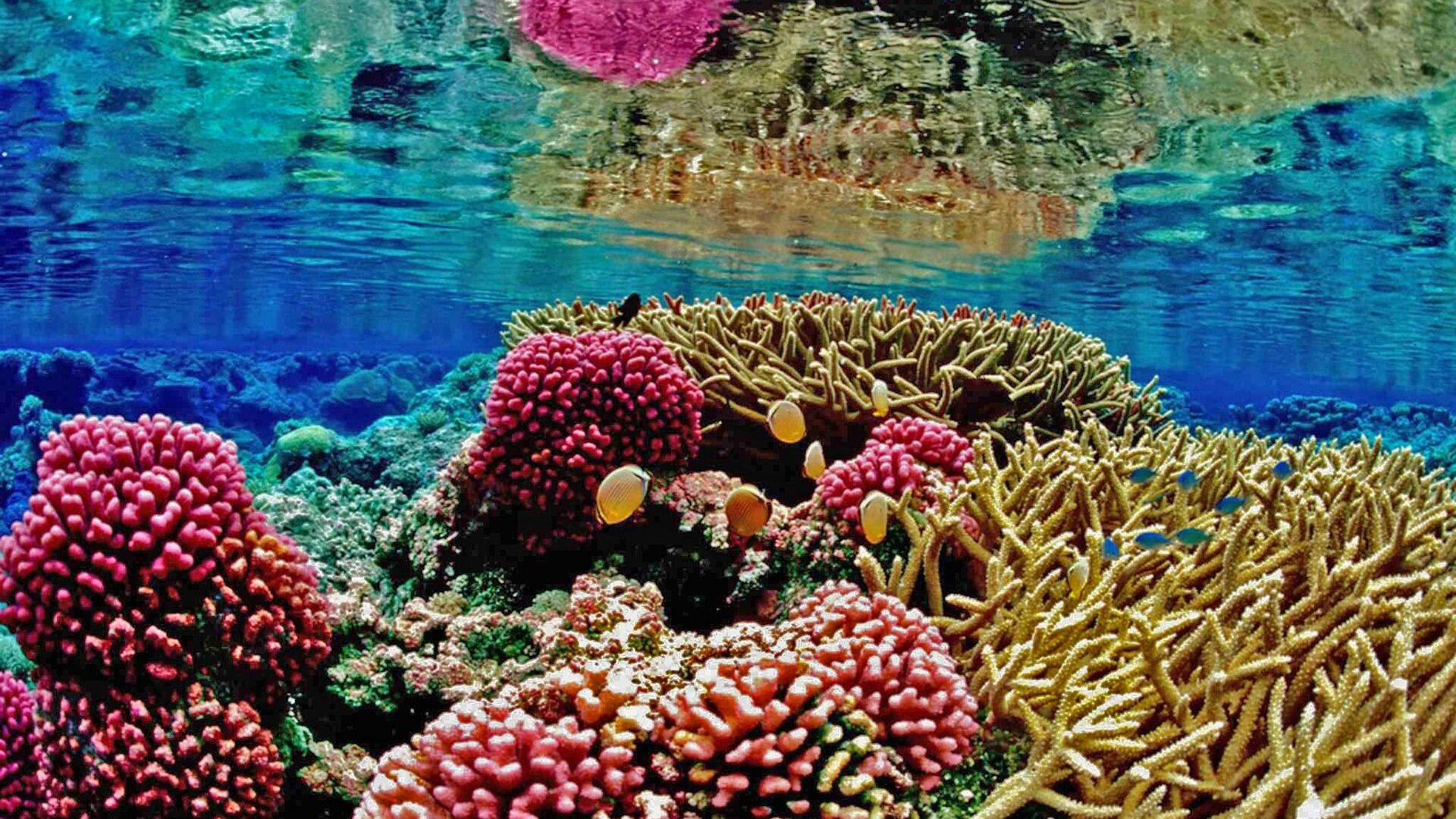https://sputnikglobe.com/20230722/florida-keys-coral-reefs-are-bleaching-due-to-record-high-temperatures-1112082590.html
Florida Keys Coral Reefs are Bleaching Due to Record-High Temperatures
Florida Keys Coral Reefs are Bleaching Due to Record-High Temperatures
Sputnik International
The coral reefs usually bleach in late August or September. But with record-breaking heat brought by El Nino and climate change, they are bleaching much earlier, and safety for the reefs from the heat is not yet in sight.
2023-07-22T21:42+0000
2023-07-22T21:42+0000
2023-07-23T04:40+0000
americas
coral reefs
florida
florida
florida keys
climate change
heat wave
noaa
national oceanic and atmospheric administration (noaa)
ocean
https://cdn1.img.sputnikglobe.com/img/107841/89/1078418972_0:99:1920:1179_1920x0_80_0_0_549d826fc44ad8e127b22e45297a4b44.jpg
Alarms are ringing for the Florida Keys coral reefs as their health is now under strain. The record-breaking heat that has smacked into the globe is causing the reefs to bleach at a faster rate than what is 'normal'. Federal scientists say the color of the reefs are turning white, when they should be vibrant and colorful this time of year.Scientists from the National Oceanic and Atmospheric Administration (NOAA) have raised the coral bleaching warning system to Alert Level 2 for the region’s reefs.An Alert Level 2 is the highest heat stress level on a five-tier scale: the first being “No Stress”, the second is “Watch”, the third level is a “Warning”, then “Alert Level 1”, and finally “Alert Level 2”. Alert Level 2 is reached when the average water surface temperature is 1.8 degrees Fahrenheit (1 degree Celsius) above the normal maximum for eight consecutive weeks.The Florida Keys have been experiencing water temperatures that are now above 90 degrees Fahrenheit (32 degrees Celsius), a temperature which is not normal for the region’s waters until late August or September.The reefs in this area typically bleach at a peak in late August or September, and bleaching for the reefs had never been recorded before August 1, says Andrew Bruckner, a research coordinator, who agrees with Lesneski’s statement, adding that some reefs were even beginning to lose their color just two weeks ago.“We are at least a month ahead of time, if not two months,” Bruckner said. “We’re not yet at the point where we are seeing any mortality... from bleaching. It is still a minor number that are completely white, certain species, but it is much sooner than we expected.”Coral bleaching occurs when coral polyps expel their algal cells which give them their color after coming under stress, which can be caused by a variety of factors including heat. While a bleached coral does not necessarily mean it is dead, it will most likely die if it remains bleached for a prolonged period of time.“Last year we started to see paling and some partial bleaching, but it wasn’t until September,” she said. “Hurricane Ian came at the end of September and knocked the temperatures down, and bleaching subsided.”This year’s El Nino in combination with climate change has created sweltering temperatures across the globe. The US state of Arizona, for example, has counted 18 people dead, with another 69 deaths under investigation. It’s possible that a tropical storm or a hurricane could form in the area, and knock down the water’s temperatures, but forecasting such an event is difficult.“If we do not reduce the greenhouse gas emissions we are emitting and don’t reduce the greenhouse gasses that are already in the atmosphere,” said Jacqueline De La Cour, operations manager for NOAA’s Coral Reef Watch program. “We are creating a world where coral reefs cannot exist, no matter what we do."
americas
florida
florida keys
Sputnik International
feedback@sputniknews.com
+74956456601
MIA „Rosiya Segodnya“
2023
Mary Manley
https://cdn1.img.sputnikglobe.com/img/07e6/01/0b/1092187887_0:0:2048:2049_100x100_80_0_0_0c2cc4c84f89aff034cc55bb01fb6697.jpg
Mary Manley
https://cdn1.img.sputnikglobe.com/img/07e6/01/0b/1092187887_0:0:2048:2049_100x100_80_0_0_0c2cc4c84f89aff034cc55bb01fb6697.jpg
News
en_EN
Sputnik International
feedback@sputniknews.com
+74956456601
MIA „Rosiya Segodnya“
Sputnik International
feedback@sputniknews.com
+74956456601
MIA „Rosiya Segodnya“
Mary Manley
https://cdn1.img.sputnikglobe.com/img/07e6/01/0b/1092187887_0:0:2048:2049_100x100_80_0_0_0c2cc4c84f89aff034cc55bb01fb6697.jpg
national oceanic and atmospheric administration, noaa, ocean, climate change, florida, marine life, florida keys, coral reefs, coral bleaching
national oceanic and atmospheric administration, noaa, ocean, climate change, florida, marine life, florida keys, coral reefs, coral bleaching
Florida Keys Coral Reefs are Bleaching Due to Record-High Temperatures
21:42 GMT 22.07.2023 (Updated: 04:40 GMT 23.07.2023) In the last 50 years, says Bruckner, the Keys have lost 80% to 90% of their coral due to climate change. Coral reefs not only support and sustain marine life, they also shield us from storm surges and hurricanes.
Alarms are ringing for the Florida Keys coral reefs as their health is now under strain. The record-breaking heat that has smacked into the globe is causing the reefs to bleach at a faster rate than what is 'normal'. Federal scientists say the color of the reefs are turning white, when they should be vibrant and colorful this time of year.
Scientists from the National Oceanic and Atmospheric Administration (
NOAA) have raised the coral bleaching warning system to Alert Level 2 for the region’s reefs.
An Alert Level 2 is the highest heat stress level on a five-tier scale: the first being “No Stress”, the second is “Watch”, the third level is a “Warning”, then “Alert Level 1”, and finally “Alert Level 2”. Alert Level 2 is reached when the average water surface temperature is 1.8 degrees Fahrenheit (1 degree Celsius) above the normal maximum for eight consecutive weeks.
The Florida Keys have been experiencing water temperatures that are now above 90 degrees Fahrenheit (32 degrees Celsius), a
temperature which is not normal for the region’s waters until late August or September.
“The corals are pale, it looks like the color’s draining out,” said Katey Lesneski, a research and monitoring coordinator for Mission: Iconic Reef. “And some individuals are stark white. And we still have more to come.”
The reefs in this area typically bleach at a peak in late August or September, and bleaching for the reefs had never been recorded before August 1, says Andrew Bruckner, a research coordinator, who agrees with Lesneski’s statement, adding that some reefs were even beginning to lose their color just two weeks ago.
“We are at least a month ahead of time, if not two months,” Bruckner said. “We’re not yet at the point where we are seeing any mortality... from bleaching. It is still a minor number that are completely white, certain species, but it is much sooner than we expected.”
Coral bleaching occurs when coral polyps expel their algal cells which give them their color after coming under stress, which can be caused by a variety of factors including heat. While a bleached coral does not necessarily mean it is dead, it will most likely die if it remains bleached for a prolonged period of time.
“The fact that we are getting this already, and there are no storms on the horizon, is terrifying,” added
Kylie Smith, vice president of I.CARE, a community-based reef restoration and conservation organization.
“Last year we started to see paling and some partial bleaching, but it wasn’t until September,” she said. “Hurricane Ian came at the end of September and knocked the temperatures down, and bleaching subsided.”
This year’s El Nino in combination with climate change has created sweltering temperatures across the globe. The US state of Arizona, for example, has counted 18 people dead, with another 69 deaths under investigation. It’s possible that a tropical storm or a hurricane could form in the area, and knock down the water’s temperatures, but forecasting such an event is difficult. “If we do not reduce the greenhouse gas emissions we are emitting and don’t reduce the greenhouse gasses that are already in the atmosphere,” said Jacqueline De La Cour, operations manager for NOAA’s Coral Reef Watch program. “We are creating a world where coral reefs cannot exist, no matter what we do."





